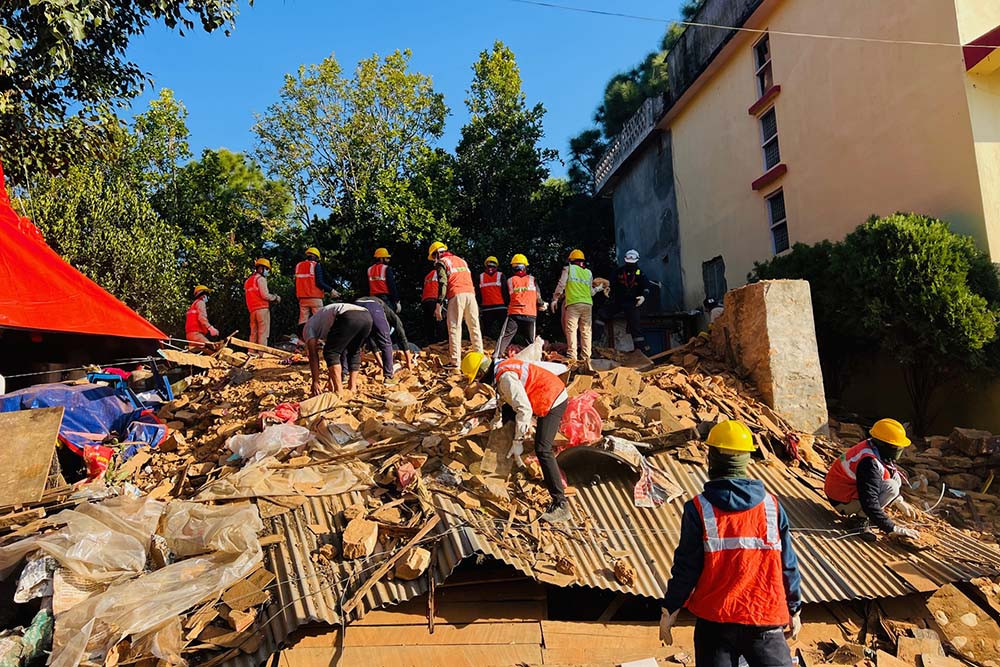
The recent earthquake on November 3 devastated Jajarkot and West Rukum claiming the lives of 157 people with several hundreds injured, and a colossal loss of property. The post-disaster needs assessment is yet to be conducted, however, preliminary investigation reveals that 5,561 houses have been totally destroyed and 10,871 are partially damaged. It is estimated that reconstruction and restoration will require billions of rupees. This is the country’s biggest tragedy after the 2015 Gorkha earthquake.
Despite frequent catastrophic incidents, Nepal has yet to give priority to developing the resilience of vulnerable communities. This has meant that in the face of a natural disaster, the loss of life and livelihood continues to grow.
Former Finance Secretary, Rameshore Khanal, shares that the numerous major catastrophes causing loss of lives and property including private and public facilities and critical lifeline infrastructure such as roads and highways in the last 30 years has accrued significant liability on the government. He called attention to the need for urgent action to cope with nature induced disasters which have compounded in recent times due to climate change impacts.
Nepal has in recent memory already faced two major earthquakes and floods in the Koshi basin are a perennial occurrence. There have been devastating floods, landslides and avalanches besides many incidents of fire.
Eight years since the 2015 Gorkha earthquake, Jajarkot and West Rukum faced the same lack of preparedness in immediate response for victims of the earthquake, specifically in areas of rescue and relief work.
A study conducted by the National Disaster Risk Reduction and Management Authority under the Ministry of Home Affairs has revealed that from 2012 to 2020, the government has spent approximately Rs 451 billion or Rs 50 billion per year in disaster response: rescue, relief, reconstruction and rehabilitation, among others. Out of Rs 410 billion committed at the donors’ conference (International Conference on Nepal’s Reconstruction), Rs 67 billion has been spent on rescue and relief efforts while Rs 49 billion from the Indian Exim Bank has been reimbursed to the government of Nepal. Hence, the actual commitment was only Rs 294 billion.
The frequency and severity of disasters that are natural or induced through human activities are increasing but what is missing is the capability build of managing disasters.
The Upper Bhotekoshi Hydroelectric Project in Sindhupalchowk District of central Nepal witnessed multiple disasters like floods, inundation and earthquake within 2015 and 16, and the cost of rehabilitation was Rs three billion, according to Narendra Prajapati, erstwhile General Manager of Bhotekoshi Power Company. Melamchi Water Supply Project faced a similar situation. The government developed the project by obtaining a loan from Asian Development Bank (ADB) and it took 22 years and expenses of Rs 30.15 billion, yet the signature government project has been unable to meet the expectations of Kathmandu denizens who were desperately waiting for the completion of the project and adequate supply of water. The project further spent around Rs 300 million in maintenance of headworks damaged by the floods, yet it remains not fully operational. There is a need to relocate the headworks as per the authorities which could cost up to Rs five billion.
Forecast of investment requirement in energy sector
|
Investment in energy production |
2030 |
2040 |
2045 |
|
Capacity (Giga Watt) |
15.2 |
28.5 |
52 |
|
Investment requirement (USD in billion) |
5.34 |
6.69 |
15.05 |
Source: Nepal's long-term strategy for net-zero emissions, Government of Nepal
Such expenses accrued as unforeseen liabilities on the government narrows down the fiscal space, according to Govinda Nepal, economist and former member of the National Planning Commission. “We have to look into viable alternatives to compensate such damages and loss caused by catastrophic incidents such as encouraging insurance coverage,” he said.
Nepal says that the loss of paddy due to floods was not covered by insurance and the government was compelled to compensate the farmers who had been affected from its coffers as they do not have insurance coverage.
The Ministry of Finance, Nepal Rastra Bank, and Nepal Insurance Authority are taking some steps to minimise risks. The Finance Ministry has made insurance coverage mandatory in construction contracts and provided 80% grant on crops and livestock insurance through its fiscal policy. It has taken the responsibility of bearing 50% of the insurance premium on interest subsidised credit mainly for the productive sector, as declared in the fiscal policy.
Nepal Rastra Bank – the central regulatory and monetary authority – has also introduced the provision of Environmental and Social (E&S) Guidelines under which banks and financial institutions (BFIs) have to develop and enforce the E&S guidelines to minimise credit risks.
Further, to encourage investment in clean and renewable energy as well as in agriculture, the central bank has introduced the provision of the issuance of green bonds for the BFIs.
Nepal Insurance Authority has been encouraging insurance coverage not only for the loan amount but the entire asset in addition to promoting insurance for crops and livestock as well to safeguard farmer interests. However, insurance penetration is still low and stands at just 39.03% of the population, according to NIA.
Climate change is the most pressing issue currently. Rapid rise of temperature in recent years despite the global commitment of nations to lower emissions requires immediate result-oriented actions from all stakeholders. Erratic monsoon and colossal loss of lives and properties have been witnessed in Nepal in recent years including impacts on crop cycle and production in agriculture. Not only the change in water discharge of snow-fed rivers due to the melting of the Himalayan glaciers but also the unexpected floods have affected crucial public services like drinking water and hydroelectricity, among others. Floods, landslides, soil erosion, inundation in terai plains, drought, erratic rainfall, drying of water sources have manifold impacts on the economy due to loss of infrastructure.
A study carried out jointly by the International Centre for Integrated Mountain Development (ICIMOD) and the United Nations Development Programme (UNDP) flagged the risk of 47 glacial bursts in Nepal, India and China. ICIMOD recently disclosed a study titled ‘Inventory of Glacier Lakes in the Koshi, Gandaki and Karnali River Basins of Nepal and Tibet, China’, and has urged for necessary precautions to minimise loss. Among these glacier lakes, 25 are in China, 21 in Nepal and one in India. Burst of glaciers threaten lower riparian people residing near riverbanks in Nepal and India.
If the global temperature remains at existing levels, the study of ICIMOD states that 80% of the snow might melt by the end of this century citing the unnatural change in glaciers, snow and deposit of snow in recent years. However, erosion of glaciers and snow-fed rivers differs in different regions. It is reported that if the temperature of the earth rises by 3°C, 75% of the snow in the Himalayan region of Nepal and Bhutan might melt and if it surges by 4°C, then 80% of the snow will melt by the end of the century.
Against this backdrop, Nepal needs regional and global cooperation to minimise the impacts of climate change and achieve its net zero emission target by 2045. Development financing in this regard needs to be delivered along with proper analysis of disaster risks in projects, according to development finance experts.
For Nepal – a low-income country with a $40 billion economy – managing resources is paramount to cope with the challenges and threats posed by climate change. Carbon trade can be the most potential source to avail resources in light of Nepal’s announcement to achieve net zero emission by 2045.
The Asian Development Bank has said that investment in clean and renewable energy will be substantive in the next decade to lower carbon emission, and Asia-Pacific investments in renewable energy generation by 2030 may double to $1.3 trillion from the previous decade. Nepal which has the potential of clean and renewable energy, i.e., hydroelectricity, could benefit from investment in energy. What is heartening is the announcement made by the Indian government to purchase 10,000 MW of electricity in the next 10 years from Nepal. Indian firms are also engaged in developing several hydroelectric projects in Nepal.
The Alternative Energy Promotion Centre (AEPC) has received Rs 2.52 billion through promotion of climate-friendly technology, its promotion and integrating it with Clean Development Mechanism. The amount has been received following the reduction of 5,198,358 tonnes of carbon through eight projects. Nawa Raj Dhakal, Executive Director of AEPC, said that among these eight projects, five are related to biogas and the remaining three are micro hydro, improved cooking solutions, and watermills.
Likewise, the Green Climate Fund (GCF) has approved the proposal submitted by AEPC regarding reducing greenhouse gas (GHG) emissions through promotion of modern, efficient and climate-friendly cooking solutions. The proposal was approved on October 6, 2021.
The GCF has been providing support to various countries in line with the Paris Agreement on Climate Change to reduce carbon emissions. In a recent interview with Business 360, Anupa Rimal Lamichhane, Regional Manager, Asia-Pacific – Division of Country Programming, Green Climate Fund, South Korea, shared that Nepal has received a total of $87.83 million from GCF for three projects, one of which directly targets providing clean energy to local communities.
AEPC has been working as the national designated authority on behalf of the Ministry of Finance to deal with GCF. The programme approved in October 2021 shall reduce 6.514 million tonnes of carbon through the distribution of at least one million clean cooking solutions – five lakh electric stoves, 490,000 three-layer improved cooking solutions – at 150 local levels of 22 districts in the terai region of Nepal. The total cost of the project including cost sharing will hover at $49.1 million or Rs 5.9 billion. The government has also received a commitment of Rs 3.33 billion from GCF to develop resilience with the holistic ecosystem for the vulnerable communities living along the riverbanks.
Experts have advised that the government focus on insurance coverage, green bonds, disaster risk reduction debentures, crowd funding-based disaster relief fund and mobilising expenses that come under corporate social responsibility in climate change adaptation and climate risk reduction activities along with carbon trade to cope with the resource constraints that the government is facing in disaster preparedness and response.

